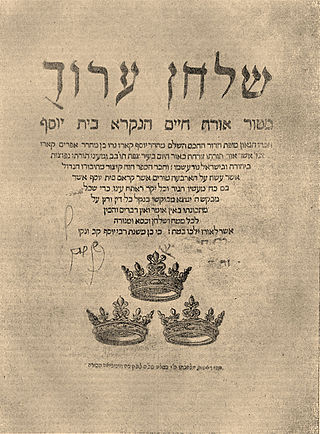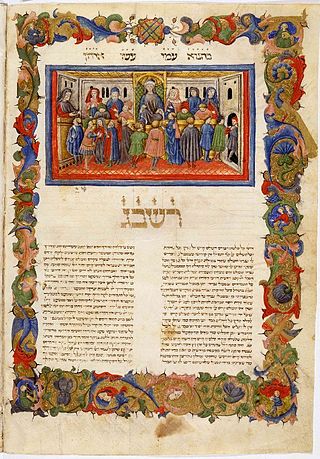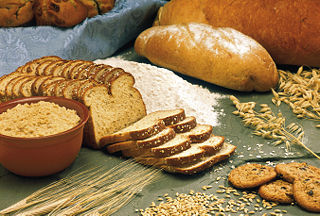Related Research Articles
Halakha, also transliterated as halacha, halakhah, and halocho, is the collective body of Jewish religious laws that are derived from the Written and Oral Torah. Halakha is based on biblical commandments (mitzvot), subsequent Talmudic and rabbinic laws, and the customs and traditions which were compiled in the many books such as the Shulchan Aruch. Halakha is often translated as "Jewish law", although a more literal translation of it might be "the way to behave" or "the way of walking". The word is derived from the root which means "to behave". Halakha not only guides religious practices and beliefs, it also guides numerous aspects of day-to-day life.
Kashrut is a set of dietary laws dealing with the foods that Jewish people are permitted to eat and how those foods must be prepared according to Jewish law. Food that may be consumed is deemed kosher, from the Ashkenazi pronunciation of the term that in Sephardic or Modern Hebrew is pronounced kashér, meaning "fit". Food that may not be consumed, however, is deemed treif, also spelled treyf.

The Shulchan Aruch, sometimes dubbed in English as the Code of Jewish Law, is the most widely consulted of the various legal codes in Judaism. It was authored in Safed, Ottoman Syria by Joseph Karo in 1563 and published in Venice two years later. Together with its commentaries, it is the most widely accepted compilation of halakha or Jewish law ever written.

Arba'ah Turim, often called simply the Tur, is an important Halakhic code composed by Yaakov ben Asher. The four-part structure of the Tur and its division into chapters (simanim) were adopted by the later code Shulchan Aruch. This was the first book to be printed in Southeast Europe and the Near East.
Kosher foods are foods that conform to the Jewish dietary regulations of kashrut. The laws of kashrut apply to food derived from living creatures and kosher foods are restricted to certain types of mammals, birds and fish meeting specific criteria; the flesh of any animals that do not meet these criteria is forbidden by the dietary laws. Furthermore, kosher mammals and birds must be slaughtered according to a process known as shechita and their blood may never be consumed and must be removed from the meat by a process of salting and soaking in water for the meat to be permissible for use. All plant-based products, including fruits, vegetables, grains, herbs and spices, are intrinsically kosher, although certain produce grown in the Land of Israel is subjected to other requirements, such as tithing, before it may be consumed.
Arukh HaShulchan is a work of halacha written by Yechiel Michel Epstein (1829–1908). The work attempts to be a clear, organized summary of the sources for each chapter of the Shulchan Arukh and its commentaries, with special emphasis on the positions of the Jerusalem Talmud and Maimonides.

Shatnez is cloth containing both wool and linen (linsey-woolsey), which Jewish law, derived from the Torah, prohibits wearing. The relevant biblical verses prohibit wearing wool and linen fabrics in one garment, the blending of different species of animals, and the planting together of different kinds of seeds.
Bava Metzia is the second of the first three Talmudic tractates in the order of Nezikin ("Damages"), the other two being Bava Kamma and Bava Batra. Originally all three formed a single tractate called Nezikin, each Bava being a Part or subdivision. Bava Metzia discusses civil matters such as property law and usury. It also examines one's obligations to guard lost property that have been found, or property explicitly entrusted to him.

In Judaism, Chadash is a concept within Kashrut, based on the Biblical requirement not to eat any grain of the new year prior to the annual Omer offering on the 16th day of Nisan.

Challah is the ninth tractate of Seder Zeraim, the Order of Seeds. It discusses the laws of the dough offering, known in Hebrew as challah.

Chalav Yisrael, also pronounced cholov Yisroel, refers to kosher milk whose milking was observed by an observant Jew. The halakha of chalav Yisrael, which originates in the Mishnah and Talmud, was instituted to ensure that no non-Jew would mix milk of a non-kosher animal with the kosher milk. Today, many kosher-keeping Jews rely on the ruling of Rav Moshe Feinstein, who argues that since countries such as the United States have strict laws against mixing milks, it can be assumed that the milk is kosher.

The tithe is specifically mentioned in the Books of Leviticus, Numbers and Deuteronomy. The tithe system was organized in a seven-year cycle, the seventh-year corresponding to the Shemittah-cycle in which year tithes were broken-off, and in every third and sixth-year of this cycle the second tithe replaced with the poor man's tithe. These tithes were akin to taxes for the people of Israel and were mandatory, not optional giving. This tithe was distributed locally "within thy gates" to support the Levites and assist the poor. Every year, Bikkurim, terumah, ma'aser rishon and terumat ma'aser were separated from the grain, wine and oil. Initially, the commandment to separate tithes from one's produce only applied when the entire nation of Israel had settled in the Land of Israel. The Returnees from the Babylonian exile who had resettled the country were a Jewish minority, and who, although they were not obligated to tithe their produce, put themselves under a voluntary bind to do so, and which practice became obligatory upon all.

Judaism prohibits shaving with a razor on the basis of a rabbinic interpretation of Leviticus 19:27, which states, "Ye shall not round the corners of your heads, neither shalt thou mar the corners of thy beard." The Mishnah interprets this as a prohibition on using a razor on the beard.
Jewish heresy refers to those beliefs which contradict the traditional doctrines of Rabbinic Judaism, including theological beliefs and opinions about the practice of halakha. Jewish tradition contains a range of statements about heretics, including laws for how to deal with them in a communal context, and statements about the divine punishment they are expected to receive.
The mixture of meat and dairy is forbidden according to Jewish law. This dietary law, basic to kashrut, is based on two verses in the Book of Exodus, which forbid "boiling a (goat) kid in its mother's milk" and a third repetition of this prohibition in Deuteronomy.
Pidyon shvuyim is a religious duty in Judaism to bring about the release of a fellow Jew captured by slave dealers or robbers, or imprisoned unjustly. The release of the captive is typically secured by reconciliation, ransom negotiations, or unrelenting pursuit. It is considered an important commandment in Jewish law.
Forbidden relationships in Judaism are intimate relationships which are forbidden by prohibitions in the Torah or rabbinical injunctions.

The gift of the foreleg, cheeks and maw of a kosher-slaughtered animal to a kohen is a positive commandment in the Hebrew Bible. The Shulchan Aruch rules that after the slaughter of animal by a shochet, the shochet is required to separate the cuts of the foreleg, cheek and maw and give them to a kohen freely, without the kohen paying or performing any service.
The following outline is provided as an overview of and topical guide to Judaism:
The prohibition of Kohen defilement to the dead is the commandment to a Jewish priest (kohen) not to come in direct contact with, or be in the same enclosed roofed space as a dead human body.
References
- ↑ "Ezekiel 18:13". Sefaria. Retrieved 28 December 2023.
- ↑ "Ezekiel 18:17". Sefaria. Retrieved 28 December 2023.
- ↑ Babylonian Talmud, Tractate Baba Metzia p. 61b.
- ↑ "Bava Metzia 61b". Sefaria. Retrieved 28 December 2023.
- ↑ Robinson, George. "Interest-Free Loans in Judaism". My Jewish Learning. Retrieved 2 January 2018.
- 1 2 3 4 5 6 7 8 9 10 11 12 13 14 15 16 17 "Usury". Jewish Encyclopedia . 1906. Retrieved 2 January 2018.
- 1 2 3 Black, M.; Rowley, H. H., eds. (1962). Peake's Commentary on the Bible (revised ed.). T. Nelson.
- ↑ Fritz M. Heichelheim, An Ancient Economic History, 2 Vols. (trans., Leiden 1965), i104-56.Cited in Johnson, A History of the Jews, p.172
- ↑ Paul Johnson (17 March 2009). History of the Jews. HarperCollins. pp. 172–3. ISBN 978-0-06-182809-6.
- ↑ Baba Batra 60a
- ↑ Deuteronomy 23:20
- ↑ Baba Metzia 63a
- ↑ Makkot 1:1
- ↑ Baba Metzia 75a
- ↑ Baba Metzia 61b
- ↑ Shulchan Aruch, Yoreh De'ah : 161:2
- ↑ Baba Metzia 68b
- ↑ Baba Metzia 5:6
- ↑ Baba Metzia 71a
- ↑ Maimonides, Mishneh Torah, Tamid:, Malweh:15
- ↑ Shulchan Aruch, Yoreh De'ah : 159
- 1 2 Shulchan Aruch, Yoreh De'ah : 160
- ↑ Shulchan Aruch, Hoshen Mishpat : 52
- ↑ Shulchan Aruch, Yoreh De'ah : 161